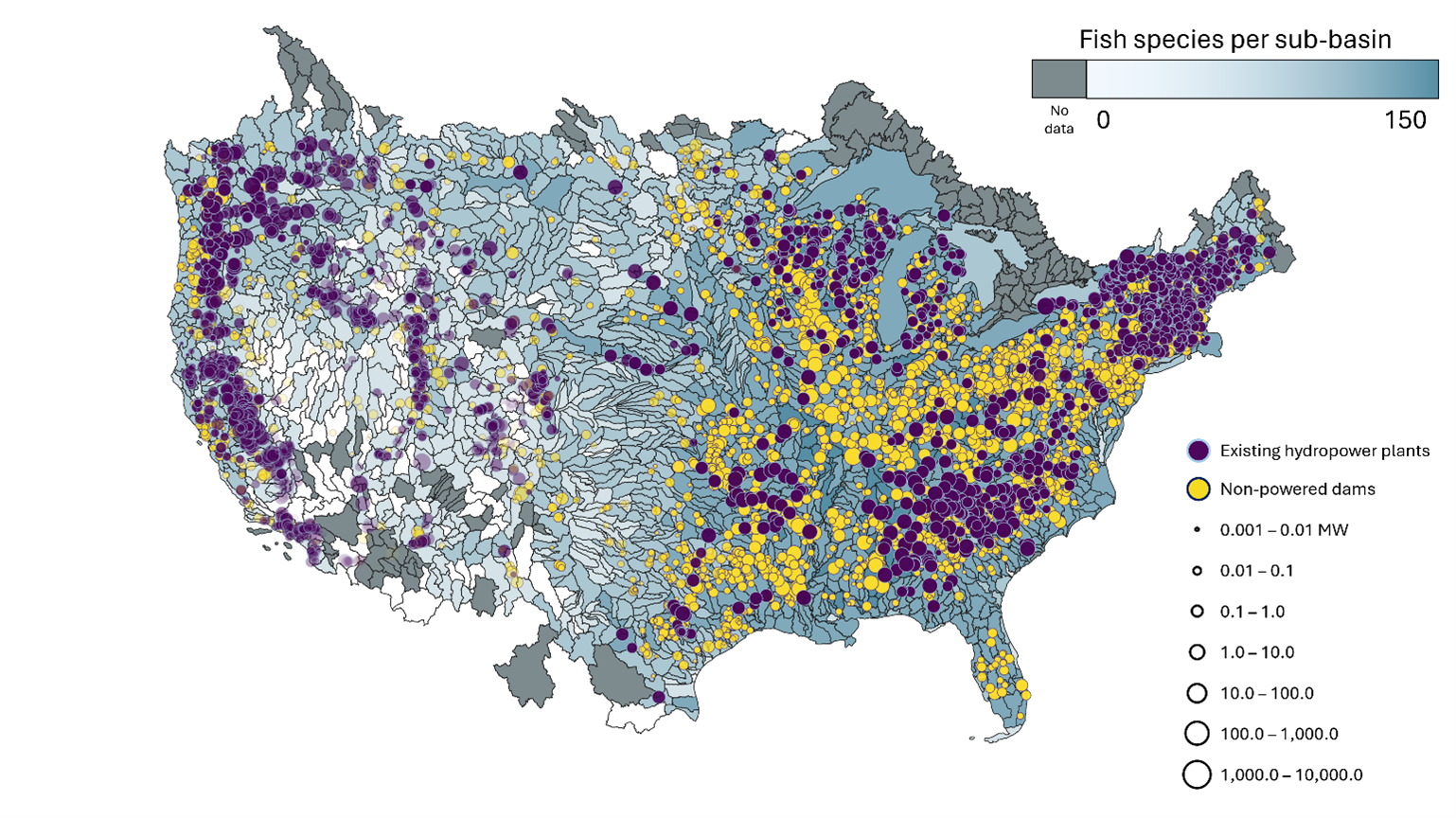
Citation
Bryan B. Bozeman, Paul G. Matson, Christopher R. Derolph and Scott T. DeNeale. 2025. HydroFish: Freshwater Fish Co-occurrence with Hydropower Plants and Non-Powered Dams in Conterminous United States Sub-basins. HydroSource. Oak Ridge National Laboratory, Oak Ridge, Tennessee, USA. DOI: 10.21951/HydroFish/2570984
Overview
The HydroFish dataset lists all existing hydropower plants (EHAs) and non-powered dams (NPDs; 0.001 MW potential nominal capacity), delineates the hydrologic sub-basins in which they are situated, and then lists all freshwater fish species reported to occur in those sub-basins. This dataset was compiled using the HydroBio dataset and contains 24 total variables that describe hydrologic sub-basins, each unique EHA (plant ID and name, geographic coordinates, permit type, capacity, etc.) and NPD (ID value, known names, geographic coordinates, and estimated potential nominal capacity), and freshwater fish species in the sub-basin (common and scientific name, origin, and migratory and threat status). The HydroBio dataset was built using Oak Ridge National Laboratory’s Existing Hydropower Assets Dataset (2024 version) and Non-powered Dam Technical Potential Dataset (2024 version), and NatureServe’s fish species distribution dataset (2023 version). The dataset also contains summary variables that report the unique number of EHAs, NPDs, and freshwater fish species per sub-basin. The HydroFish dataset contains two unique data files: 1) a .csv metadata file describing the dataset variables, and 2) a .csv data file containing the actual dataset. Note that there may be many rows per unique existing hydropower plant or non-powered dam given that distinct species are listed per existing plant or NPD per sub-basin. The dataset is downloadable as a zip file containing the metadata and dataset files.
The HydroFish dataset was produced through federal funding from the US Department of Energy’s Water Power Technologies Office as a part of the Standard Modular Hydropower (SMH) Technology Acceleration project. The SMH project promotes standardization, modularity, and environmental compatibility as three enabling principles of a low-cost, environmentally compatible hydropower growth strategy. Through research and development efforts focused on applications of hydropower to new stream reach development and non-powered dam retrofits, ORNL emphasized the importance of balancing power production and the related technical and economic objectives with environmental objectives, including maintaining environmental conditions, such as biodiversity. This dataset reflects this multi-purpose strategy for balancing social demands with environmental stewardship and enables decision-making through application of two key parameters affecting water resource management.
Methods
The HydroFish dataset was constructed using Oak Ridge National Laboratory’s (ORNL) HydroBio dataset (Bozeman et al., 2025). The non-powered dam and existing hydropower plant components of the HydroBio dataset were assembled from ORNL’s NPD Technical Potential Dataset (Hansen et al., 2024) and Existing Hydropower Assets Plant Database (Johnson et al., 2024). The freshwater fish origin, status, and distribution component of the dataset was compiled from NatureServe’s freshwater species distribution dataset (NatureServe, 2020; https://explorer.natureserve.org/), the International Union for the Conservation of Nature’s Red List of Threatened Species (IUCN, 2024; https://www.iucnredlist.org/), and the North American Freshwater Migratory Fish Database (NAFMFD; Dean et al., 2022). The freshwater fish distribution information from NatureServe was last updated in spring of 2023. Lastly, sub-basin delineation information was sourced from the USGS Watershed Boundary Dataset (WBD; U.S. Geological Survey, 2024). Detailed descriptions of data procurement, cleaning, and unification are presented on the HydroBio webpage. The HydroFish dataset will support the hydropower community by informing decisions about hydropower development and operation in the context of freshwater biodiversity.
References
Dean, E. M., Cooper, A. R., Wang, L., Daniel, W., David, S., Ernzen, C., Gido, K. B., Hale, E., Haxton, T. J., & Kelso, W. (2022). The north American freshwater migratory fish database (NAFMFD): Characterizing the migratory life histories of freshwater fishes of Canada, the United States and Mexico. Journal of Biogeography, 49(6), 1193-1203. https://www.usgs.gov/data/north-american-freshwater-migratory-fish-database-nafmfd-characterizing-migratory-life
Hansen, C. H., Gallego Calderon, J., Bastidas Pacheco, C., Davis, C., Mendadhala, R., & Russell, G. (2024). Technical Potential for Hydropower Capacity at Non-powered Dams. HydroSource. Oak Ridge National Laboratory, Oak Ridge, TN, USA. https://doi.org/10.21951/HydroCapacity_NPD/2570407
IUCN. (2024). The IUCN Red List of Threatened Species Version 2024-1). https://www.iucnredlist.org/
Johnson, M. M., Kao, S.-C., & Uria-Martinez, R. (2024). Existing Hydropower Assets (EHA) Plant Database. HydroSource. Oak Ridge National Laboratory (ORNL), Oak Ridge, TN, USA. https://doi.org/10.21951/EHA_FY2024/2344934
NatureServe. (2020). Digital Distribution Maps of the Freshwater Fishes in the Conterminous United States Version Version 4.0. Last update: May 2023. https://www.natureserve.org/
U.S. Geological Survey. (2024). National Hydrography Products: Watershed Boundary Dataset. https://www.usgs.gov/national-hydrography/access-national-hydrography-products
Science Themes
Related Records
HydroBio: Hydropower Capacity and Freshwater Biodiversity in Conterminous United States Sub-basins
This dataset summarizes existing and potential hydropower capacity and freshwater biodiversity at the sub-basin level throughout the conterminous United States (CONUS).
View DatasetExisting Hydropower Assets (EHA) Plant Database, 2024
The Existing Hydropower Assets (EHA) Plant Database is a geospatially comprehensive point-level dataset containing locations and key characteristics of U.S. hydropower plants that are currently operational.
View DatasetTechnical Potential for Hydropower Capacity at Non-powered Dams
This dataset contains estimates of technical potential capacity and generation at 2,616 NPDs in the conterminous US based on a subset of dams that were found by earlier resource assessments to have at least 100kW of theoretical potential.
View Dataset